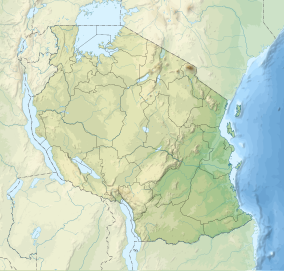Nyerere National Park
This article, Nyerere National Park, has recently been created via the Articles for creation process. Please check to see if the reviewer has accidentally left this template after accepting the draft and take appropriate action as necessary.
Reviewer tools: Inform author |
| Nyerere National Park | |
|---|---|
| Selous Game Reserve | |
 | |
| Coordinates | 9°0′S 37°24′E / 9.000°S 37.400°E |
| Area | 30,893 km2 |
| Established | 2019 |
| Governing body | Tanzania National Parks Authority |
| tanzaniaparks | |
Nyerere National Park (formerly: Selous, pronunciation: "saluu") is the largest national park in Tanzania, also one of the world's largest wildlife sanctuaries. The total area of the park is 30,893 km2 (11,928 sq mi) and covers the Coast, Morogoro, Lindi, Mtwara and Ruvuma regions.[1] The area is larger than 70 countries in the world and is estimated to be twice the size of Costa Rica (Central America) and about twice the size of Belgium (Europe). Much of the area is in a natural state without being disturbed by human activities.
History
The park was established in 1922 as a game reserve known as the Selous; before being gazetted as a National Park in 2019. The park was named in honour of the first President of Tanzania, Mwalimu Julius Kambarage Nyerere.[2][3]
The original name recognises Frederick Selous, a British hunter during the colonial establishment of South and East Africa, who was killed in present-day Tanzania as a soldier during the First World War. Since 1982 it has been included in the UNESCO World Heritage List. In June 2014 it was added to UNESCO's list of endangered species.[4]
Wildlife
Nyerere National Park is home to several species of wildlife: lions, wildebeests, giraffes, zebras, hippopotamuses, rhinos, antelopes, hyenas, African wolves, and a large number of crocodiles in the Rufiji River. Previously the Selous game reserve was home to a large number of elephants but due to extreme poaching, the numbers have dropped dramatically.
See also
Further reading
- Baldus, Rolf D.; Siege, Ludwig; Jafferji, Javed (2005). Selous Game Reserve. Gallery Publications. ISBN 9789987667468.
References
- ^ "The Newly-Established Nyerere National Park". EABWNews. 5 February 2020. Retrieved 7 January 2021.
- ^ Yinglun, Shi, ed. (29 July 2019). "Tanzania starts process to establish Nyerere National Park in Selous". Xinhuanet. Retrieved 7 January 2021.
- ^ Lyimo, Henry (25 November 2019). "New Nyerere National park established". Daily News (Tanzania). Retrieved 7 January 2021.
- ^ "Nyerere National park overview". www.zepisaafricansafaris.com. Zepisa African safaris.
This article, Nyerere National Park, has recently been created via the Articles for creation process. Please check to see if the reviewer has accidentally left this template after accepting the draft and take appropriate action as necessary.
Reviewer tools: Inform author |


